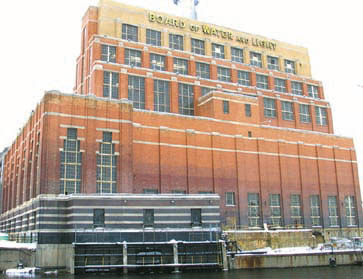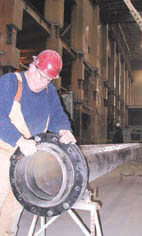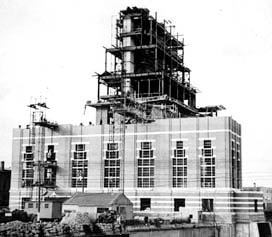Big chill project revives Ottawa Street Station
Date Posted: January 19 2001
LANSING - The fortunes of the Lansing Board of Water and Light's Ottawa Street Station have turned from hot to cold. And that's a good thing for the preservation of a handsome, landmark building.
The building trades, in conjunction with the BWL and construction manager Clark Construction Co. are in the process of converting the former 16-story power plant that provided steam and electricity to the city, into a facility that houses a chilled water system that will cool downtown buildings.
The building, whose footprint spreads over 210,000 square-feet, was shut down as a power producer in 1992 and left vacant. Steam and electrical production were transferred to the nearby Eckert Station."It's a wonderful piece of architecture, located in the center of the capital of Michigan, and it has been a pet project of mine to get a developer in there for the last 10 years," said Board of Water and Light Director and General Manager Joseph Pandy, Jr.
Various proposals over the last decade to redevelop the Ottawa Street Station into office or commercial space or as an entertainment venue never worked out. Within the utility, the concept of installing a chilled water system and the related piping to cool downtown buildings caught on, and the centralized location of the old Ottawa Street Station made it an ideal place to install the water chillers.
The looped chilled water system, which has a 20,000-ton capacity, is expected to be up and running in time for the summer 2001 cooling season. The project will cost about $34 million. Chillers at the Ottawa Street Station will cool the water to 42 degrees, then pumps will move the water through buried pipes to buildings in the business district. Cooling coils inside the buildings will use the water for air conditioning, then the water will be re-circulated back to the chillers at about 57 degrees.
Buildings owned by the State of Michigan, including the State Capitol Building, are among those that will air condition their buildings with the system, giving the Board of Water and Light a built-in customer base.
Jack Hill, director of central utilities and chilled water for the Board of Water and Light, said such systems are on the increase among utility providers. He said the advantages to the customer include not having to purchase and maintain their building's own individual chillers, new buildings can be built without having to allow for the extra weight and cost of mechanical cooling systems, "and it should result in a lower cost for the customer," he said.
Hill said major difficulties in this project have not been at the Ottawa Street Station itself, but has involved the tearing up of 11 blocks of city streets in order to install some 14,000 feet of pipe.
"The existing buried utilities were a hodge-podge, and we didn't always have accurate drawings," Hill said. "So we didn't always know what we were getting in to, and it's difficult to change the direction of the pipe."
Plans are also being finalized for the building to act as an "Internet hotel" or "convergence center" for the city, with the building as a termination point for runs throughout Lansing for video, broad-band, and fiber optic cables. The building could act as a nerve center for providers of communication services.
The high-technology wiring and chiller plans are a far cry from the original use of the building. It took about three years to build the Ottawa Street Station, originally a 25,000 kilowatt coal-burning plant which was dedicated in 1939. The building won accolades for its design, which concealed the coal-burning and electrical generation processes on the inside with the façade of a stately office building on the outside.
At the time, Power Plant Engineering magazine stated in its review that "the Ottawa Street station represents a milepost by which technical progress in the industry may well be measured."
Times, technology and the need for more power changed over the years. The interior of the plant was upgraded and eventually included five turbines. A real smokestack was also added on after the original construction - because designers swung and missed on the concept that the building could get by with a smokestack only 13 inches taller than the building's roof. Back drafts of exhaust gases into the building necessitated the construction of single smokestack.
Eventually, however, more modern power plants built by the BWL produced power and steam more effectively.
"We're glad that the building is being re-used," Pandy said.

DEDICATED IN 1939, the Lansing Board of Water and Light's Ottawa Street Station won kudos at the time for making a downtown power plant look...nice. The color and materials of the building's exterior brickwork have meaning, according to an original brochure put out by the BWL. "Symbolizing the combustion of coal," it said, "the polished black of its granite base gives way to a purple gray in the lower masonry. Then, as the eye travels upward, the grays dissolve into reds, deep at first, then brilliant and lighter until they merge into orange. Higher still, the hues change to brighter yellows. And at the very top the color blends into yellow gray."

A FLANGE for a 14-inch chilled water line is installed by Mike Cozzins of Plumbers and Pipe Fitters 333, working on the Ottawa Street Station's old turbine floor.

HERE is a photo of the power plant under construction in 1938.
